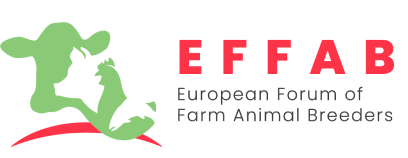Reproduction Techniques
Reproduction techniques are becoming more and more important and necessary for modern animal breeding. Reproduction techniques are used to make safe and efficient breeding and to deliver genetic progress to farmers.
Breeding programmes can be improved and optimised through the use of reproductive techniques. Reproductive techniques allow the dissemination of genetic progress to farmers. These technologies can bring a lot of advantages, but can also evoke strong emotions from the society.
By the technique of Artificial Insemination (AI) semen is collected from an adult male, preserved fresh or frozen and send to farms to inseminate cows, sheeps, goats and sows. Collected bovine semen is often stored or transported in frozen form, which makes this technique suitable for global use or storage. In the porcine sector, semen is often stored and transported in fresh form. After 72 hours, semen is not anymore fertile and which makes more difficult larger dissemination. In those cases, boars need to be transported to semen collection centres close to farms.
Since a few decades the technology of sexing semen is commercialised; but in some species still under development.
Embryo transfer is the transfer of an embryo from a superior donor female and implanted in a surrogate mother. In this technique disease transmission is even more minimised, compared to AI.
Embryo transfer can be combined with super ovulation. This method stimulates female animals to produce many more ova, and thus embryos, than they would naturally do.
Cloning is another method of multiplying improved animals, currently not used for animal production in Europe. Potentially cloning can be used to produce genetic copies of individuals and for dissemination of genetic progress but it may also be used to introduce a new or endangered breed into a country without risk of disease transmission by transport of animals. Today cloning in farm animal breeding is done for research purposes and not for production of milk, meat or eggs.
In the aquaculture or fish farming there are other reproductive techniques used. Monosexing is used in order to prevent the natural maturing process of male fish whereby quality of meat and growth rate decline. In this technique the temperature at which fish are raised are altered, so that the fish become outwardly female. In fish such as trout, monosex female fry will grow to commercial weight before maturation.
Another technique used in fish farming is triploidisation, also triggered by thermal treatment. This treatment generates fish with three sets of chromosomes instead of the usual two. Triploid fish are very useful, as they cannot interbreed or contaminate with wild populations. Similar to monosex fish, they have delayed maturation.
Animal Identification and Data Recording
Breeding Organisations work to identify animals without errors, to keep accurate records, and to improve data recording. Animal identification and trait recording are fundamental for all breeding programmes. The recording can be done within a breeding unit or organised as field recording. Recording of phenotypic data is the major driving force for genetic progress. This genetic progress is very much dependent on the accuracy of the data.
Conventional Breeding
In many species, the selection candidates' own performance and the performance of their relatives are measured for several traits. Statistical methods are used to estimate breeding values from these data. A combination of breeding values for several traits can be pooled into a selection index, and the animal with the best index are selected from breeding. In some species, where it is difficult or expensive to control mating and therefore to identify relatives, selection can be based on an individual's own performance only (mass selection).
Related articles
Related pages
Other informations
